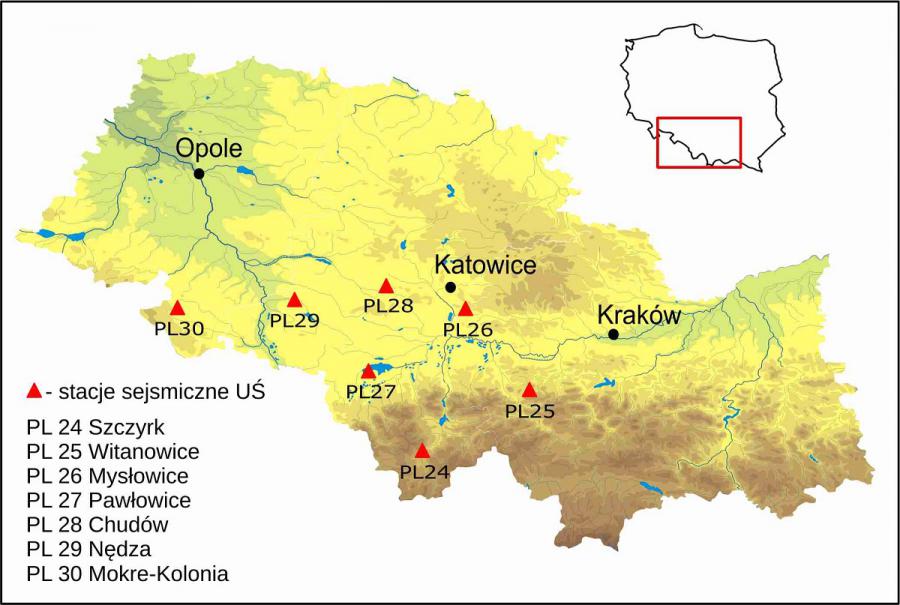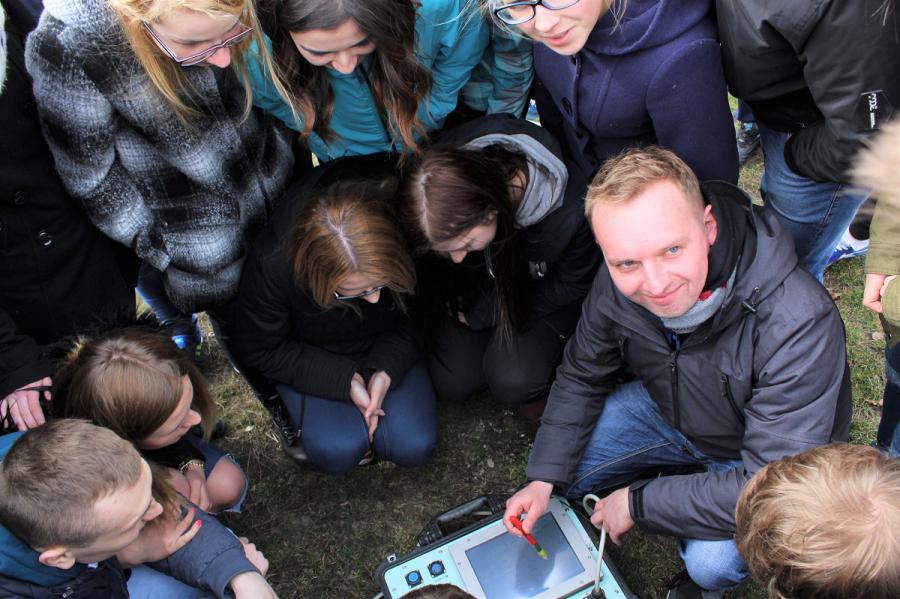| Małgorzata Kłoskowicz |
Probably most of the Upper Silesia inhabitants at least once in their lives have felt vibrations resulting from tremors due to the mining activity. The last stronger tremor of a magnitude of 3 was registered on 19 May 2019 in Katowice-Murcki. What do we know about these rapid phenomena? Why we cannot yet foresee them? These and other questions are answered by Maciej Mendecki, PhD, from the Faculty of Natural Sciences, who deals with seismicity induced by mining activity.
The black gold
Maciej Mendecki, PhD, is a physicist and geologist; he carries out research in applied geology. Together with other scientists, he tries to harness nature with the use of knowledge in geology. The main task of people engaged in this discipline is searching for precious deposits, e.g. oil or gas, and in the case of Upper Silesia, coal. However, there are individuals who – based on the newest knowledge – want to counteract the negative effects of the rapid phenomena related to tectonic movement and human activity. To this group belongs Maciej Mendecki, PhD, who emphasises the fact that Upper Silesia is a suitable place to carry out such research.
“Coal mining is nothing else than removing blocks of coal of a proper volume at a proper depth beneath the ground. Usually, it is a cuboid of a 1-kilometre length, the width of 100-150m, and a few metres of height,” says the scientist.
The result of such an activity is chapping and tension around the exploitation hollow. Along with the tension, the so-called elastic energy accumulates in the rocks. As it usually happens in such situations, there is a certain critical point one would rather not exceed. Otherwise, there might be abrupt destruction of rock material.
“Unfortunately, the rocks located at Upper Silesia have a low yield point according to Hooke’s law; it is due to their structure, thus, seismic tremors are common. Although I have good news as well. Fortunately, not that much elastic energy accumulates in this structure; therefore, the tremors are not severe, and the damage on the surface is not as dramatic as in other regions in the world,” adds the geo-physician.
It is also interesting to note that although in Poland there are no natural conditions favouring severe phenomena related to earthquakes, our region is one of the most seismologically active areas in the world; it is due to human activity. Apart from Upper Silesia, the Legnica-Głogów Copper District also finds its place among the leaders. Undoubtedly, the place on a list depends on… the country’s policy.
The change of a system affects the tremors’ frequency
Maciej Mendecki, PhD, looks at the history of seismic activity within the area of Upper Silesia and Zagłębie with great interest.
“In this case, we can talk about a certain rhythm determined by the economic and political changes. Let’s scrutinise the data archives. The number of registered mining industry-induced tremors was rapidly increasing in the 60s and 70s during Gierek’s days. It decreased later in the times of the 80s crisis. And then was the regime change in Poland, and in the 90s the mining activity once again increased,” comments the researcher.
He also adds that recent years are a very interesting and even surprising time. The recently realised policy of giving up on the mining industry for green energy should result in a decrease in the number of tremors; however, the data shows that although the number of seismic events decreased, their severity increased. In the past, a severe and noticeable by inhabitants tremor occurred once per year, nowadays, we can observe three or four tremors within 365 days.
A severe tremor is one of a magnitude of over 3.
“I would like to pay attention specifically to this term. In news, we usually can hear values given in the Richter scale, which is erroneous as this scale was developed and adjusted to the conditions in… California. In order to assess the severity of a tremor at Upper Silesia, we needed an empirical relationship developed for that purpose. It has been done by employees of the Central Mining Institute,” emphasises Maciej Mendecki, PhD.
What information gives us the magnitude, then? If its value exceeds 4, objects located in buildings shake, the plasterwork may fall off, or a cupboard door may open. The value of 5 often means more serious damage to buildings, whereas the value of 7 and 8 means that entire estates or other infrastructure may be razed to the ground.
Distribution of seismological stations of the University of Silesia | Drawing by M. Mendecki, PhD
Where is the epicentre?
It is hard to describe the experience of a tremor caused by an earthquake. It is a powerful force that shakes a whole building along with everything inside of it. It is an unusual form of sway, which has nothing in common with pleasure or relaxation.
“Interestingly, the first time when I have experienced such a tremor was not at Upper Silesia, but in the centre of Tbilisi, Georgia, during my doctoral studies internship. It was a tremor that occurred 2 kilometres below the earth’s surface. Due to the vertical direction of the waves, everything around, including me, at once was tossed for a fraction of a second,” recalls the scientist.
He also admits that based on the vibration analysis, we can pinpoint their source as their direction is consistent with the direction of the propagated wave. Such a tremor can give information about the entire history of an earthquake, just as the ECG test gives information about our health state. For example, inhabitants of Sosnowiec reported that swaying occurs most often towards the south-west and north-east, which transparently indicates the source in the mine in Katowice.
Only this year, there were 21 tremors of a magnitude above 3 registered in the area of Upper Silesia. People interested in examining the frequency, severity, and location of tremors can check the data on the Upper Silesian Regional Seismological Network website run by the Upper Silesia Mining Institute.
Maciej Mendecki, PhD, encourages people to report noticeable tremors.
“This information greatly helps us in monitoring these processes; due to the great number of occurring geological phenomena, it is hard to indicate the ones that are induced by mining activity. I recommend the official application by the European Mediterranean Seismological Centre (EMSC). These a few clicks are invaluable clues for us,” says.
Data regarding earth tremors are gathered by the University of Silesia in Katowice. It is one of two universities in Poland creating their own seismological network. The other one is the University of Warsaw.
“We have seven stands, which are the part of the Pannonian-Carpathian-Alpine Seismic Experiment international project. Numerous research units in Europe have joined forces and created equipment to monitor tremors across the area from the Mediterranean Sea to the Baltic Sea. Our network was launched at the end of 2019 and is located in Opole Voivodeship, Upper Silesia, Beskidy, and the western part of Lesser Poland. The data is transmitted to the Institute of Geophysics of the Polish Academy of Sciences, our project partner. For the sake of the project, 30 sensors are working in Poland alone, whereas over 200 of them are working in Europe. The research is still being carried out. Thanks to them we hope to develop even better tools that will serve to counteract the aftermaths of human activity and allow for a better understanding of the Alpine-Carpathian area,” says the scientist.
“Watch out! The tram is coming…
…while it is coming, the ground is shaking,” sang Artur Rojek in one of his songs. We deal with vibrations on a daily basis. We do not have to live in areas with well-developed mining industries or great tectonic plates overlapping with each other.
This is the so-called seismic noise caused by Baltic waves, a driving tram, a working power plant, etc.
“We have learnt how to use this noise to carry out research in applied geology in order to counter the consequences of more severe tremors,” says the researcher.
Although currently, scientists do not have enough knowledge and equipment to foresee their occurrence, we are not fully defenceless against nature. Experts can calculate the probability of an earthquake occurring in a given area.
“We have our successes in this field. Along with Łukasz Wojtecki, PhD, we plan to estimate the effectiveness of the so-called torpedo blasting, which allows defusing the external stresses in controlled conditions in order to decrease the probability of tremors due to mining activity. Together with Prof. Wacław Zuberek, we have developed a quantitative method of examining the effectiveness of this process, and that is a great step towards forecasting seismic events,” sums up the scientist from the University of Silesia.
The Earth’s ECG test article was published in June issue No. 9 (289) of the University of Silesia Magazine.
Maciej Mendecki, PhD, from the Faculty of Natural Sciences | Photo from the archives of M. Mendecki, PhD







